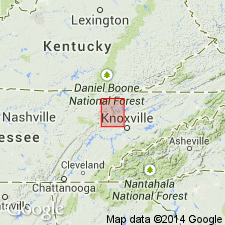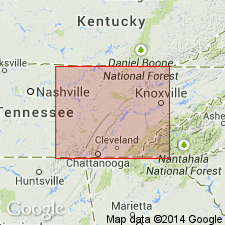
- Usage in publication:
-
- Anderson sandstone*
- Modifications:
-
- Original reference
- Dominant lithology:
-
- Sandstone
- Shale
- Coal
- AAPG geologic province:
-
- Appalachian basin
Summary:
Anderson sandstone [of Pottsville group]. Sandstones, sandy and argillaceous shales, and coal beds, like preceding formations [Scott, Wartburg, and Briceville]. Bottom of series is marked by massive sandstones in beds from 20 to 50 feet thick, with total thickness of 100 to 120 feet. Above these follow 300 to 400 feet of shales interbedded with thin layers of massive sandstone which are capped in higher mountains by thick, massive sandstones like bottom layers. Appears on mountain tops. Original thickness unknown, but 650 feet remain. Overlies Scott shale. [Age is Pennsylvanian.]
Named because of its frequent occurrence in Anderson Co, eastern TN.
Source: US geologic names lexicon (USGS Bull. 896, p. 51).

- Usage in publication:
-
- Anderson formation[†]
- Modifications:
-
- [Abandoned]
- AAPG geologic province:
-
- Appalachian basin
Summary:
Pg. 1. Name Anderson formation discontinued. In new classification presented, sediments formerly described as Anderson are redefined and included in Cross Mountain and Vowell Mountain groups (both new).
[Abandoned. See Vowell Mountain and Cross Mountain.]
Source: US geologic names lexicon (USGS Bull. 1200, p. 96).
For more information, please contact Nancy Stamm, Geologic Names Committee Secretary.
Asterisk (*) indicates published by U.S. Geological Survey authors.
"No current usage" (†) implies that a name has been abandoned or has fallen into disuse. Former usage and, if known, replacement name given in parentheses ( ).
Slash (/) indicates name conflicts with nomenclatural guidelines (CSN, 1933; ACSN, 1961, 1970; NACSN, 1983, 2005, 2021). May be explained within brackets ([ ]).

